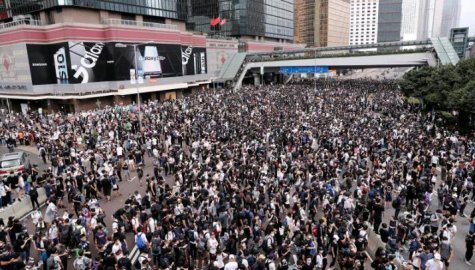Chen Minlan: Economic risks are high. As the benchmark interest rates further decrease, the importance of yield strategy will be more important, and diversified layouts are more important than ever before.
Trade friction has been upgraded again and quickly extended to a new front, making investors have to consider changing strategies.
Just a few days before the latest round of economic and trade consultations in China and the United States, US President Trump suddenly issued several tweets on May 10, accusing China of disrupting the agreement.The White House subsequently increased the tariff rate of US $ 200 billion in goods from China to 25%from 10%to 25%, and threatened all tariffs on the remaining US $ 325 billion in Chinese transmission and American products.China immediately took countermeasures to impose tariffs on US $ 60 billion in US goods.
Subsequently, the US measures were further upgraded: On May 16th, the US Department of Commerce included the Chinese technology giant Huawei in the export control entity list, which was actually equivalent to cutting off the supply of key components of American companies to Huawei.Although the White House was officially implemented for 90 days, it means that this move means that the conflict is seriously upgraded and there is a risk of extending to the non -trade field.
It is worth noting that this may lead to the start of the Cold War between the two major economies of the world and develop ecosystems in China and the United States or respectively.This will have a significant and far -reaching impact on the entire technology industry, stock market and global economy.Considering this possibility and the pressure brought by the financial market in the short term, how should investors lay out?We believe that seeking yield and diversified investment is the key.
The trade war can be resolved
At present, both China and the United States seem to be rushing to reach an agreement.The US economic performance is stable, and the unemployment rate is 3.6%at a low of 50 years.Toughness in China also helps Trump's support in the United States.The Chinese economy has gradually stabilized under the policy of steady growth.Moreover, any agreement reached with the United States must reflect a win -win situation, and China cannot be regarded as the containment and bullying of the United States.
Sino -US friction is likely to continue for a long time.However, the factors that were introduced to the negotiating table had not changed: the matter was heavy to both parties, and no one could lose.If the trade negotiations are completely ruptured, the United States impose tariffs on all Chinese goods, and China pays attention to non -tariff barriers, then we estimate that the GDP growth rate of the two countries will fall by 1 percentage point.The decline will also reach 15ndash; 20%, the US dollar may rise to 7.3 against RMB.
Therefore, in order to reduce losses, the most likely scene is that both parties have made concessions and reached an agreement. Part of the withdrawal of tariffs has been withdrawn. The structural change required by the United States is resolved.Our benchmark is that China and the United States will reach an agreement at a certain point before the end of 2019.
Scientific and technological threat is another code
The United States decided to break the confession against Huawei.Re -adjusting the rules of trade relations and market access, intellectual property protection and technical transfer are the goals that the United States and their main allies want to achieve, and are supported by Chinese liberals and elite elements, but the Trump administration'sPriority matters seem to have shifted to curb the rise of China and become a power of technology.Whether the United States can achieve this goal remains questionable, but recently in the United States to curb Huawei's actions will have a significant impact on the entire technology industry.
If the Huawei ban becomes permanent measures (the White House may also cancel the ban, like another Chinese company ZTE), Huawei's smartphone and telecommunications infrastructure business will be suffered from major losses.As far as smart phones are concerned, competitors will quickly occupy the market share of Huawei lost; for telecommunications infrastructure, the situation is more complicated. Huawei not only leads the cost efficiency, but also has more advanced technology, especially 5G.
It will have a significant impact on the overall development of 5G and related supply chains outside the door of Huawei. The profitability of the Asian technology industry may decline in medium -digit, of which Taiwan has the largest impact (medium and high single digits).During this period, the pressure of global hardware and semiconductor manufacturers is still very great, so it is a wise move to avoid these two industries.
Whether Beijing will take countermeasures still needs to be observed, such as restricting the Rare Earth MDASH to the United States; - This move may greatly limit the ability to make high -tech products in the United States and trigger further revenge in the United States.This vicious circle will cause the company to reduce expenses, which will damage global economic growth and lead to pressure on the financial market.
The situation may not be here.However, over time, the technology industry may be split into two major camps, led by the United States and China and their respective technology giants.With the increasing competition and the development, migration and decoupling of the new supply chain, it is even more important to have diversified investment and avoid excessive concentration worldwide, whether it is in the United States, China, or technology.
How should investors lay out?
Economic risks are high. At present, it seems that the central bank may maintain low interest rates for a longer period of time.Therefore, the importance of the yield strategy will be increasingly exposed. For example, holding the sovereign debt of emerging markets priced in the US dollar, compared with US Treasury bonds, there is a spread of 357 basis points;NT $) and make one more basket of high -interest emerging market currencies (Indonesian Shield, Indian rupee, South African Rand).
As far as the Asia -Pacific region is concerned, the yield of high -yield bonds in Asia is as high as 7.5%, which is quite attractive, and it is relatively small due to the trade war.In the past, the real estate investment trust funds (REITs) we favored in Hong Kong and Singapore are currently high.Investors who seek to build a new position may get better returns from local banks and Chinese banks. The two are relatively stable, and the dividend yields are as high as 5.0% and 5.8%, respectively.
For investors, although uncertainty is currently filled, this does not mean to completely withdraw from the market. Although the road of future negotiations is more rugged, the trade agreement may still be reached.As the benchmark interest rate further decreases, investors should seize the opportunity to obtain yields, and the diversified layout is more important than ever before.
(The author is Chief Investment Director of the Asia -Pacific Region in UBS. This article only represents the author's point of view. Responsible editor email: [email protected])



